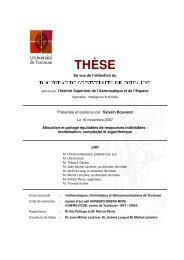- Page 1 and 2: Graphical Languages for Preference
- Page 3 and 4: Introduction to compact preference
- Page 5 and 6: Introduction to compact preference
- Page 7 and 8: Introduction to compact preference
- Page 9 and 10: Introduction to compact preference
- Page 11 and 12: Introduction to compact preference
- Page 13: Introduction to compact preference
- Page 17 and 18: Introduction to compact preference
- Page 19 and 20: Introduction to compact preference
- Page 21 and 22: Introduction to compact preference
- Page 23 and 24: Languages for compact preference re
- Page 25 and 26: Languages for compact preference re
- Page 27 and 28: Languages for compact preference re
- Page 29 and 30: Languages for compact preference re
- Page 31 and 32: Languages for compact preference re
- Page 33 and 34: Languages for compact preference re
- Page 35 and 36: Languages for compact preference re
- Page 37 and 38: Languages for compact preference re
- Page 39 and 40: Logical and bidding languages - Pro
- Page 41 and 42: Logical and bidding languages - Pro
- Page 43 and 44: Logical and bidding languages - Pro
- Page 45 and 46: Logical and bidding languages - Pro
- Page 47 and 48: Logical and bidding languages - Pro
- Page 49 and 50: Logical and bidding languages - Pro
- Page 51 and 52: Logical and bidding languages - Pro
- Page 53 and 54: Logical and bidding languages - Pro
- Page 55 and 56: Logical and bidding languages - Pro
- Page 57 and 58: Logical and bidding languages - Pro
- Page 59 and 60: Logical and bidding languages - Pro
- Page 61: Logical and bidding languages - Bid
- Page 64 and 65:
Logical and bidding languages - Bid
- Page 66 and 67:
Logical and bidding languages - Bid
- Page 68 and 69:
Logical and bidding languages - Bid
- Page 70 and 71:
Logical and bidding languages - Bid
- Page 72 and 73:
Logical and bidding languages - Bid
- Page 74 and 75:
Logical and bidding languages - Bid
- Page 76 and 77:
Graphical languages for ordinal pre
- Page 78 and 79:
Graphical languages for ordinal pre
- Page 80 and 81:
Graphical languages for ordinal pre
- Page 82 and 83:
Graphical languages for ordinal pre
- Page 84 and 85:
dsc 1 ≻ nsc 1 ; dsc 2 ≻ nsc 2 ;
- Page 86 and 87:
Graphical languages for ordinal pre
- Page 88 and 89:
N ̸ d¯sc 1 ≻ n¯sc 2 and N ̸ n
- Page 90 and 91:
Graphical languages for ordinal pre
- Page 92 and 93:
Graphical languages for ordinal pre
- Page 94 and 95:
Graphical languages for ordinal pre
- Page 96 and 97:
Graphical languages for ordinal pre
- Page 98 and 99:
Graphical languages for ordinal pre
- Page 100 and 101:
Graphical languages for ordinal pre
- Page 102 and 103:
Graphical languages for ordinal pre
- Page 104 and 105:
Graphical languages for ordinal pre
- Page 106 and 107:
Graphical languages for ordinal pre
- Page 108 and 109:
Graphical languages for ordinal pre
- Page 110 and 111:
Graphical languages for cardinal pr
- Page 112 and 113:
Graphical languages for cardinal pr
- Page 114 and 115:
Graphical languages for cardinal pr
- Page 116 and 117:
Graphical languages for cardinal pr
- Page 118 and 119:
Graphical languages for cardinal pr
- Page 120 and 121:
Graphical languages for cardinal pr
- Page 122 and 123:
Graphical languages for cardinal pr
- Page 124 and 125:
Graphical languages for cardinal pr
- Page 126 and 127:
Graphical languages for cardinal pr
- Page 128 and 129:
Graphical languages for cardinal pr
- Page 130 and 131:
a utility ratio function w(x M |x K
- Page 132 and 133:
Graphical languages for cardinal pr
- Page 134 and 135:
Collective decision makingOutline1
- Page 136 and 137:
Collective decision making - Voting
- Page 138 and 139:
Collective decision making - Voting
- Page 140 and 141:
Collective decision making - Voting
- Page 142 and 143:
Collective decision making - Voting
- Page 144 and 145:
Collective decision making - Voting
- Page 146 and 147:
Collective decision making - Voting
- Page 148 and 149:
Collective decision making - MultiA
- Page 150 and 151:
Collective decision making - MultiA
- Page 152 and 153:
Collective decision making - MultiA
- Page 154 and 155:
Collective decision making - MultiA
- Page 156 and 157:
Collective decision making - MultiA
- Page 158 and 159:
Collective decision making - MultiA
- Page 160 and 161:
monotonic: π ⊆ π ′ ⇒ π ≼
- Page 162 and 163:
Collective decision making - MultiA
- Page 164 and 165:
Collective decision making - MultiA
- Page 166 and 167:
Collective decision making - MultiA
- Page 168 and 169:
Collective decision making - MultiA
- Page 170 and 171:
Collective decision making - MultiA
- Page 172 and 173:
Collective decision making - MultiA
- Page 174 and 175:
Collective decision making - MultiA
- Page 176 and 177:
Collective decision making - MultiA
- Page 178 and 179:
Collective decision making - MultiA
- Page 180 and 181:
Collective decision making - MultiA
- Page 182 and 183:
Collective decision making - MultiA
- Page 184 and 185:
Collective decision making - MultiA
- Page 186 and 187:
Collective decision making - MultiA
- Page 188 and 189:
Collective decision making - MultiA
- Page 190 and 191:
Collective decision making - MultiA
- Page 192 and 193:
ConclusionConclusionGraphical langu
- Page 194 and 195:
Bouveret, S. and Lang, J. (2008).Ef
- Page 196 and 197:
Gonzales, C., Perny, P., and Queiro
- Page 198:
Bell Journal of Economics, pages 40




